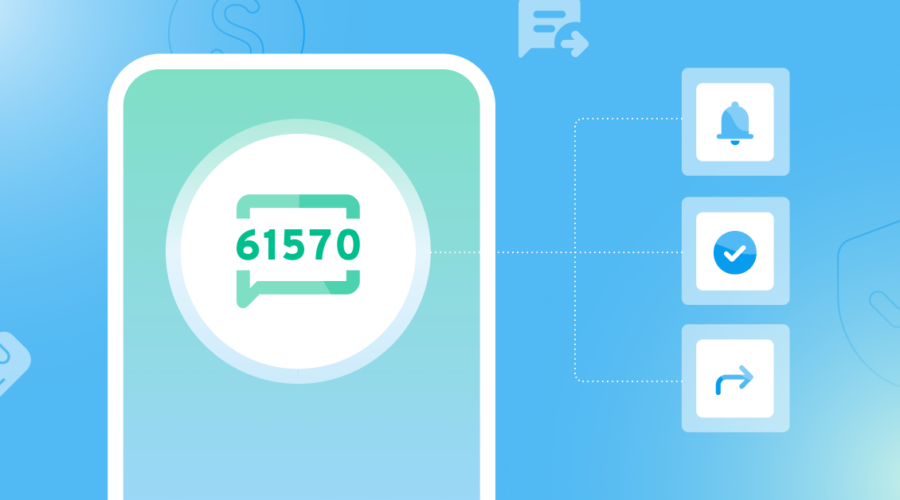Application-to-Person (A2P) messaging
A2P Meaning
A2P Messaging (Application-to-Person Messaging), sometimes called business SMS or enterprise SMS, refers to SMS or MMS messages sent from a business to a person.
Types of A2P numbers
There are 3 types of A2P Messaging based on what kind of phone number the messages are sent from: toll-free messaging, 10 digit long code (10DLC), and short codes. Each type has different implications for cost, functionality, and deliverability.
| Feature | Short Codes | Toll-free | 10DLC |
| Geographic availability | Globally with country-specific codes | US/CAN | US (CAN as P2P) |
| Voice Capable | No | Yes | Yes |
| SMS 2-Way | Yes | Yes | Yes |
| Multimedia Capable | Yes | Yes | Yes |
| Expected Time to Market | 8 Weeks | 3-4 Weeks | 1 Week |
| Expense | $$$ | $$ | $ |
Pros & cons of A2P Messaging
Benefits of A2P Messaging
- Automation: Unlike P2P (Person-to-Person/Peer-to-Peer) messaging, A2P Messaging allows businesses to automate text messaging for appointment reminders, two-factor authentication, text message alerts, text-based sales promotions, and more.
- Insights: With A2P messaging, businesses can also power functionality like conversation tracking within a CRM, multi-channel support conversations, and personalized marketing outreach.
- Engagement: A2P MMS and SMS text messaging has a higher response rate compared to other communication methods, like email and voice calls.
- Customization: Organizations can personalize messages sent to customers for a tailored, individualized recipient experience.
Downsides of A2P Messaging
- Regulatory compliance. The messaging ecosystem must try to “self-regulate” via regulatory requirements. When messaging was just between individuals on their phones (P2P), little oversight was needed—most traffic was balanced and considered “wanted” by receiving parties. Now,
- A2P misuse. As the messaging ecosystem has evolved, APIs and software for automated messages has spurred significant consumer demand and innovation but has also created new challenges with SPAM. With more demand for consumer-to-business communication, many fear it could lead to more fraud, spam, and other unwanted messaging traffic.
Unlike voice telecom (which is regulated by the FCC), text messaging is actually categorized as an Information Service. Without a common set of procedures to manage them, the messaging ecosystem could be at risk of devolving into an inundated channel like email. Thus A2P messaging was created by the Cellular Telecommunications Industry Association (CTIA) to allow for differentiation as businesses utilize messaging more and more.
What is the CTIA?
Straight from the source, the ‘CTIA represents the U.S. wireless communications industry.’ Part of the CTIA’s mission is to ‘Convene the industry to tackle our most difficult challenges and coordinate voluntary best practices and initiatives.’
Changes to A2P Messaging regulations include:
- 2017 – The CTIA releases the first Messaging Principles and Best Practices document, defining volumetric guidelines to help identify person-to-person (P2P) or consumer traffic from non-consumer traffic (also called application-to-person or A2P)
- 2019 – The CTIA releases an update to the Messaging Principles and Best Practices, redefining A2P or business text messaging traffic as “a business, organization, or entity that uses 2016—business text messaging on toll-free phone numbers finally takes off, growing 300% YoY with Bandwidth as one of the first providers
- 2019 – AT&T releases updated Code of Conduct to reflect the recently announced A2P policies
Three types of A2P business messaging
The CTIA defined 3 types of business messaging and laid out opt-in requirements for each one. Note which types of messaging your business is using today, and make sure you have all the necessary opt-ins in place. If you’re unsure, it’s worth asking where your phone number lists are coming from, to make sure you aren’t texting customers who’ve never actively opted in.
Conversational messaging
Conversational messaging, or consumer-initiated messaging allows for consent to be implied, so no additional opt-in is required.
Informational messaging
Informational messaging, when a consumer gives their phone number to a business, asking to be notified of account updates, appointments, etc., requires express consent but that can be as simple as a consumer agreeing to receive messages by completing a form via text, verbally, or on a website.
Promotional messaging
Promotional messaging, which is any text that promotes or markets a business in any way, has the most stringent consent requirements. Express written permission is required before a consumer receives a text, meaning consumers may opt in via a checkbox on a website, a signed form, or another web form that is continually tracked and managed.
Does A2P messaging architecture differ from P2P?
Yes. The path of a business message does differ slightly in its structure than a standard P2P message. P2P messages rely only on a user’s mobile phone, wireless connection, and their carriers.
Business messages travel via a different channel, through various aggregators and spam filters to protect end users, before being delivered to the user’s carrier that then applies their own spam filter to determine if the message should be delivered to the user. Depending on the type of messaging (toll-free, short code, or 10DLC), that path will vary slightly as well.
How Bandwidth is involved with A2P messaging?
Bandwidth believes that our customers deserve fast and reliable text messaging to reach their customers. With Bandwidth’s Messaging API, texting has never been easier to integrate and manage using simple on-demand, cloud-based API platforms. As the demand has shifted from “hosted VoIP phone service” running on our PCs to a new generation of “virtual phone numbers for applications”, CRM systems now find it easier to create add-on services for voice and texting, just like a traditional VoIP system does.
Bandwidth’s Messaging API allows our customers to add powerful SMS, MMS, toll-free, short code, local 10DLC (10 digit long code), and group messaging functionalities to an app in just a few minutes. From there, businesses can optimize, track, and enhance communication with their customers through the endless possibilities of SMS integration.
A2P FAQs
A2P Messaging (Application-to-Person Messaging), sometimes called business SMS or enterprise SMS, refers to SMS or MMS messages sent from a business to a person.
Unlike P2P (Person-to-Person/Peer-to-Peer) messaging, A2P Messaging allows businesses to automate text messaging for appointment reminders, two-factor authentication, text message alerts, text based sales promotions, and more. With A2P messaging, businesses can also power functionality like conversation tracking within a CRM, multi-channel support conversations, and personalized marketing outreach.
Toll-free messaging, 10 digit long code (10DLC), and short codes.
A2P stands for “application to person” and P2P stands for “peer to peer / person to person”.
Conversational, informational, and promotional.
Yes. The path of a business message does differ slightly in its structure than a standard P2P message. P2P messages rely only on a user’s mobile phone, wireless connection, and their carriers. Business messages travel via a different channel, through various aggregators and spam filters to protect end users, before being delivered to the user’s carrier that then applies their own spam filter to determine if the message should be delivered to the user. Depending on the type of messaging (toll-free, short code, or 10DLC), that path will vary slightly as well.




